Business Environment Analysis: Tesco's Organizational Structure
VerifiedAdded on 2023/01/18
|11
|2628
|97
Report
AI Summary
This report provides a comprehensive analysis of Tesco's business environment, focusing on its organizational structure and its relationship with business objectives. It begins by explaining different types of organizations, including public, voluntary, and private sectors, using Tesco, Oxfam, and the BBC as examples. The report then delves into the legal structure of Tesco, outlining the roles and responsibilities of key positions such as the Board of Directors, Chairman, and Chief Executive. It examines how Tesco's hierarchical organizational structure aligns with its business objectives, highlighting its role in creating products and services, encouraging efficiency, optimizing resource use, and ensuring specialization. The report also critically analyzes the complexities within various business structures, such as dual channels of direction and operational complexities, and emphasizes the importance of interrelationships between organizations. It concludes by underscoring how organizational structure serves as a framework for dividing and coordinating various members of the organization, ultimately contributing to enhanced productivity and profitability.
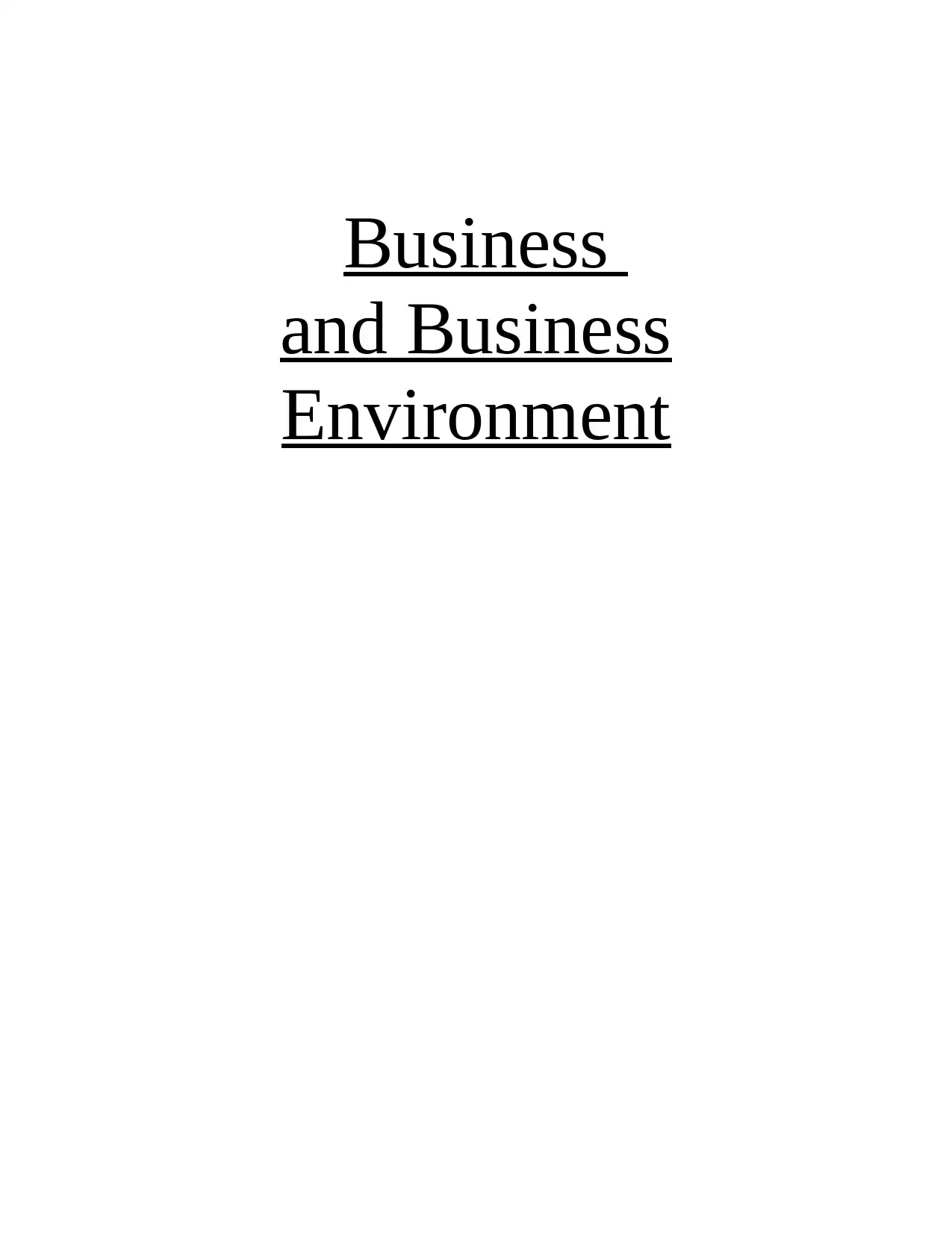
Business
and Business
Environment
and Business
Environment
Paraphrase This Document
Need a fresh take? Get an instant paraphrase of this document with our AI Paraphraser
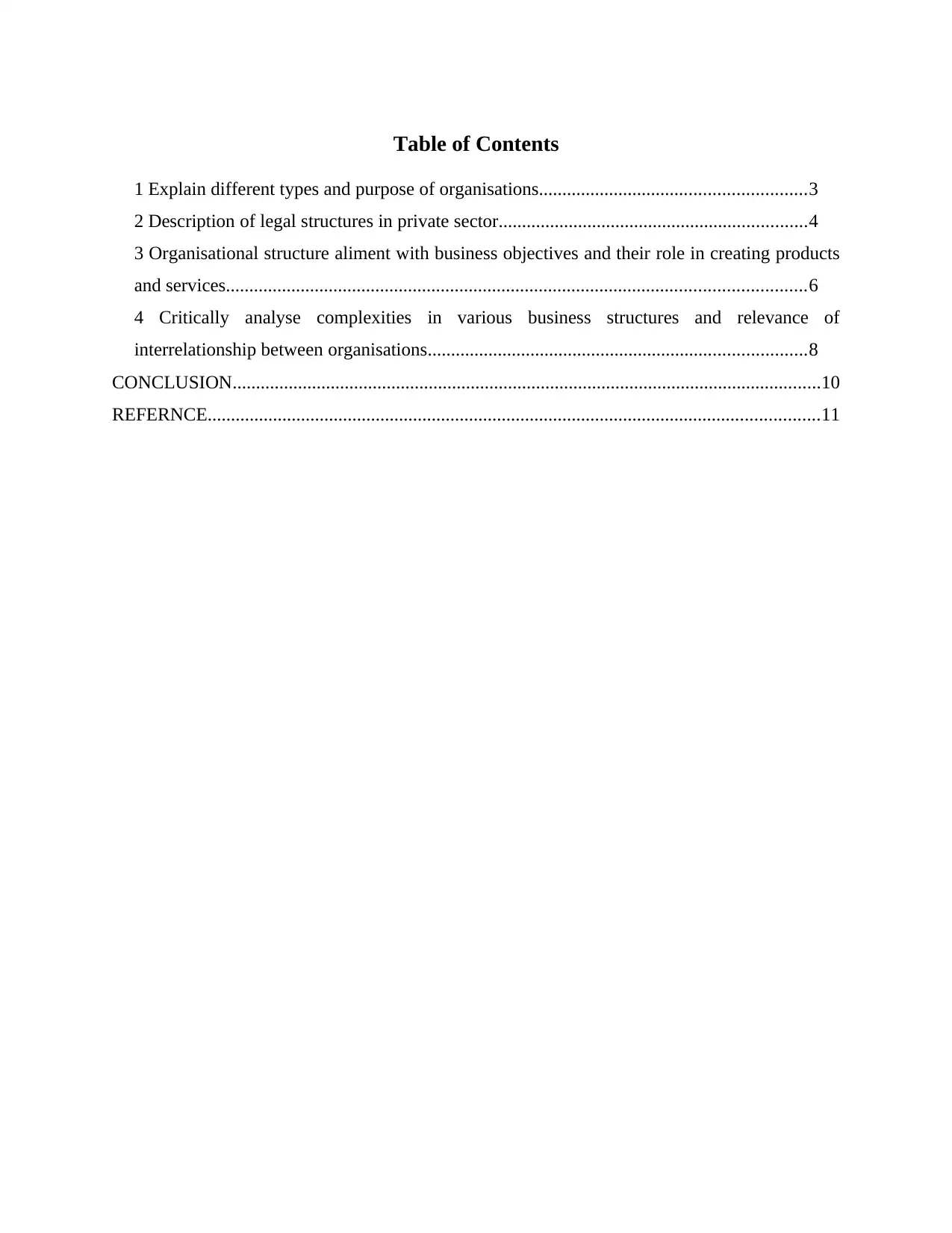
Table of Contents
1 Explain different types and purpose of organisations.........................................................3
2 Description of legal structures in private sector..................................................................4
3 Organisational structure aliment with business objectives and their role in creating products
and services............................................................................................................................6
4 Critically analyse complexities in various business structures and relevance of
interrelationship between organisations.................................................................................8
CONCLUSION..............................................................................................................................10
REFERNCE...................................................................................................................................11
1 Explain different types and purpose of organisations.........................................................3
2 Description of legal structures in private sector..................................................................4
3 Organisational structure aliment with business objectives and their role in creating products
and services............................................................................................................................6
4 Critically analyse complexities in various business structures and relevance of
interrelationship between organisations.................................................................................8
CONCLUSION..............................................................................................................................10
REFERNCE...................................................................................................................................11
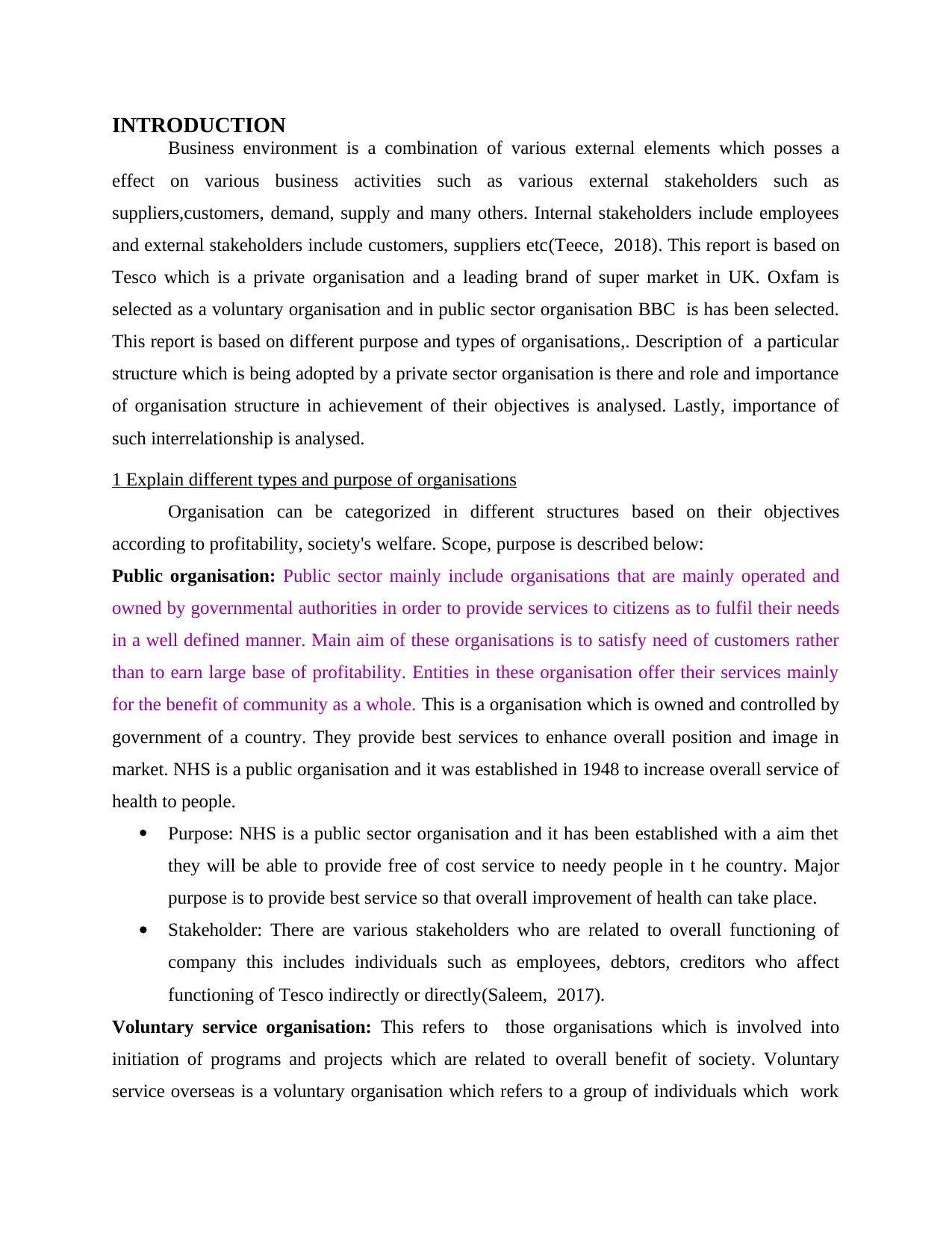
INTRODUCTION
Business environment is a combination of various external elements which posses a
effect on various business activities such as various external stakeholders such as
suppliers,customers, demand, supply and many others. Internal stakeholders include employees
and external stakeholders include customers, suppliers etc(Teece, 2018). This report is based on
Tesco which is a private organisation and a leading brand of super market in UK. Oxfam is
selected as a voluntary organisation and in public sector organisation BBC is has been selected.
This report is based on different purpose and types of organisations,. Description of a particular
structure which is being adopted by a private sector organisation is there and role and importance
of organisation structure in achievement of their objectives is analysed. Lastly, importance of
such interrelationship is analysed.
1 Explain different types and purpose of organisations
Organisation can be categorized in different structures based on their objectives
according to profitability, society's welfare. Scope, purpose is described below:
Public organisation: Public sector mainly include organisations that are mainly operated and
owned by governmental authorities in order to provide services to citizens as to fulfil their needs
in a well defined manner. Main aim of these organisations is to satisfy need of customers rather
than to earn large base of profitability. Entities in these organisation offer their services mainly
for the benefit of community as a whole. This is a organisation which is owned and controlled by
government of a country. They provide best services to enhance overall position and image in
market. NHS is a public organisation and it was established in 1948 to increase overall service of
health to people.
Purpose: NHS is a public sector organisation and it has been established with a aim thet
they will be able to provide free of cost service to needy people in t he country. Major
purpose is to provide best service so that overall improvement of health can take place.
Stakeholder: There are various stakeholders who are related to overall functioning of
company this includes individuals such as employees, debtors, creditors who affect
functioning of Tesco indirectly or directly(Saleem, 2017).
Voluntary service organisation: This refers to those organisations which is involved into
initiation of programs and projects which are related to overall benefit of society. Voluntary
service overseas is a voluntary organisation which refers to a group of individuals which work
Business environment is a combination of various external elements which posses a
effect on various business activities such as various external stakeholders such as
suppliers,customers, demand, supply and many others. Internal stakeholders include employees
and external stakeholders include customers, suppliers etc(Teece, 2018). This report is based on
Tesco which is a private organisation and a leading brand of super market in UK. Oxfam is
selected as a voluntary organisation and in public sector organisation BBC is has been selected.
This report is based on different purpose and types of organisations,. Description of a particular
structure which is being adopted by a private sector organisation is there and role and importance
of organisation structure in achievement of their objectives is analysed. Lastly, importance of
such interrelationship is analysed.
1 Explain different types and purpose of organisations
Organisation can be categorized in different structures based on their objectives
according to profitability, society's welfare. Scope, purpose is described below:
Public organisation: Public sector mainly include organisations that are mainly operated and
owned by governmental authorities in order to provide services to citizens as to fulfil their needs
in a well defined manner. Main aim of these organisations is to satisfy need of customers rather
than to earn large base of profitability. Entities in these organisation offer their services mainly
for the benefit of community as a whole. This is a organisation which is owned and controlled by
government of a country. They provide best services to enhance overall position and image in
market. NHS is a public organisation and it was established in 1948 to increase overall service of
health to people.
Purpose: NHS is a public sector organisation and it has been established with a aim thet
they will be able to provide free of cost service to needy people in t he country. Major
purpose is to provide best service so that overall improvement of health can take place.
Stakeholder: There are various stakeholders who are related to overall functioning of
company this includes individuals such as employees, debtors, creditors who affect
functioning of Tesco indirectly or directly(Saleem, 2017).
Voluntary service organisation: This refers to those organisations which is involved into
initiation of programs and projects which are related to overall benefit of society. Voluntary
service overseas is a voluntary organisation which refers to a group of individuals which work
⊘ This is a preview!⊘
Do you want full access?
Subscribe today to unlock all pages.

Trusted by 1+ million students worldwide
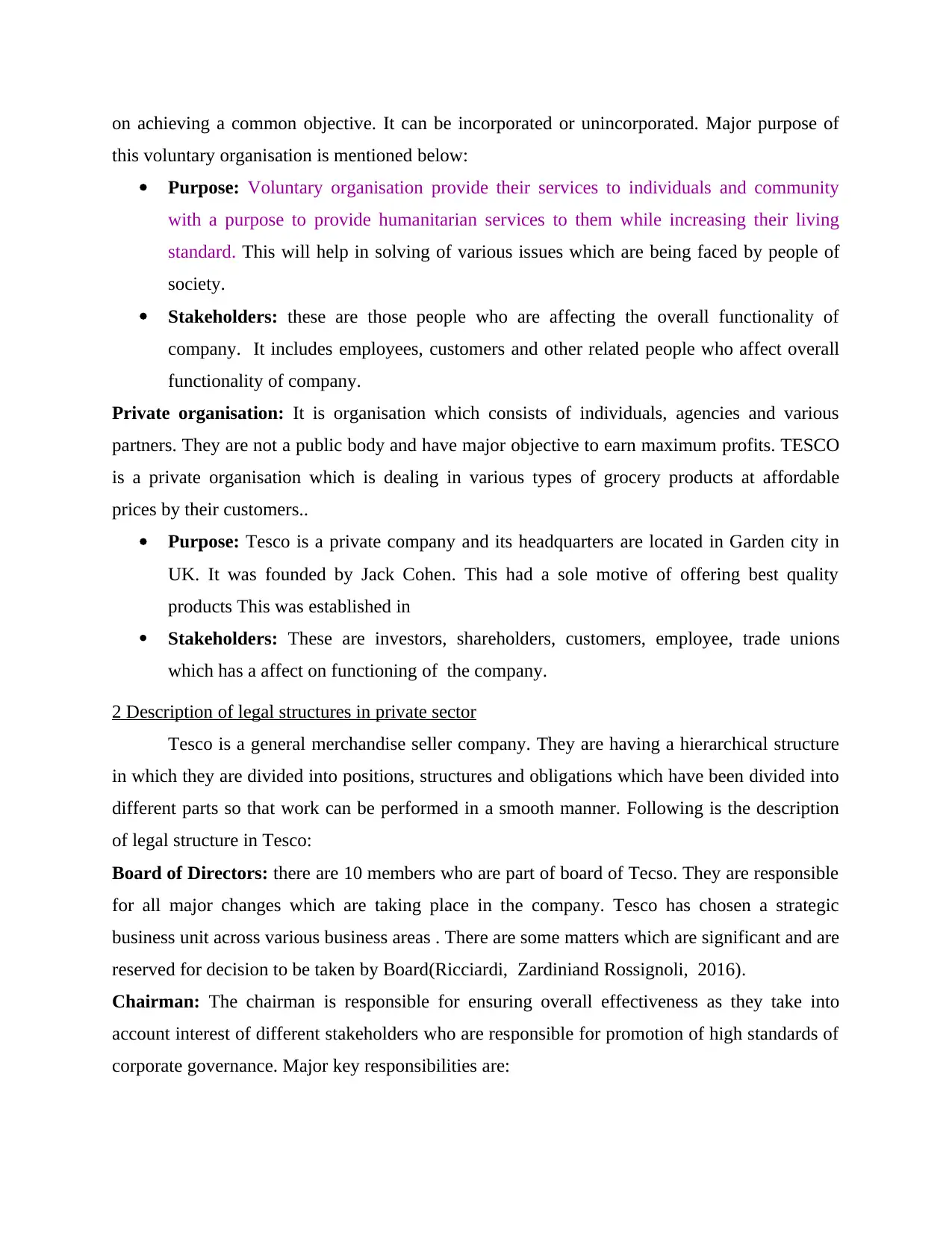
on achieving a common objective. It can be incorporated or unincorporated. Major purpose of
this voluntary organisation is mentioned below:
Purpose: Voluntary organisation provide their services to individuals and community
with a purpose to provide humanitarian services to them while increasing their living
standard. This will help in solving of various issues which are being faced by people of
society.
Stakeholders: these are those people who are affecting the overall functionality of
company. It includes employees, customers and other related people who affect overall
functionality of company.
Private organisation: It is organisation which consists of individuals, agencies and various
partners. They are not a public body and have major objective to earn maximum profits. TESCO
is a private organisation which is dealing in various types of grocery products at affordable
prices by their customers..
Purpose: Tesco is a private company and its headquarters are located in Garden city in
UK. It was founded by Jack Cohen. This had a sole motive of offering best quality
products This was established in
Stakeholders: These are investors, shareholders, customers, employee, trade unions
which has a affect on functioning of the company.
2 Description of legal structures in private sector
Tesco is a general merchandise seller company. They are having a hierarchical structure
in which they are divided into positions, structures and obligations which have been divided into
different parts so that work can be performed in a smooth manner. Following is the description
of legal structure in Tesco:
Board of Directors: there are 10 members who are part of board of Tecso. They are responsible
for all major changes which are taking place in the company. Tesco has chosen a strategic
business unit across various business areas . There are some matters which are significant and are
reserved for decision to be taken by Board(Ricciardi, Zardiniand Rossignoli, 2016).
Chairman: The chairman is responsible for ensuring overall effectiveness as they take into
account interest of different stakeholders who are responsible for promotion of high standards of
corporate governance. Major key responsibilities are:
this voluntary organisation is mentioned below:
Purpose: Voluntary organisation provide their services to individuals and community
with a purpose to provide humanitarian services to them while increasing their living
standard. This will help in solving of various issues which are being faced by people of
society.
Stakeholders: these are those people who are affecting the overall functionality of
company. It includes employees, customers and other related people who affect overall
functionality of company.
Private organisation: It is organisation which consists of individuals, agencies and various
partners. They are not a public body and have major objective to earn maximum profits. TESCO
is a private organisation which is dealing in various types of grocery products at affordable
prices by their customers..
Purpose: Tesco is a private company and its headquarters are located in Garden city in
UK. It was founded by Jack Cohen. This had a sole motive of offering best quality
products This was established in
Stakeholders: These are investors, shareholders, customers, employee, trade unions
which has a affect on functioning of the company.
2 Description of legal structures in private sector
Tesco is a general merchandise seller company. They are having a hierarchical structure
in which they are divided into positions, structures and obligations which have been divided into
different parts so that work can be performed in a smooth manner. Following is the description
of legal structure in Tesco:
Board of Directors: there are 10 members who are part of board of Tecso. They are responsible
for all major changes which are taking place in the company. Tesco has chosen a strategic
business unit across various business areas . There are some matters which are significant and are
reserved for decision to be taken by Board(Ricciardi, Zardiniand Rossignoli, 2016).
Chairman: The chairman is responsible for ensuring overall effectiveness as they take into
account interest of different stakeholders who are responsible for promotion of high standards of
corporate governance. Major key responsibilities are:
Paraphrase This Document
Need a fresh take? Get an instant paraphrase of this document with our AI Paraphraser
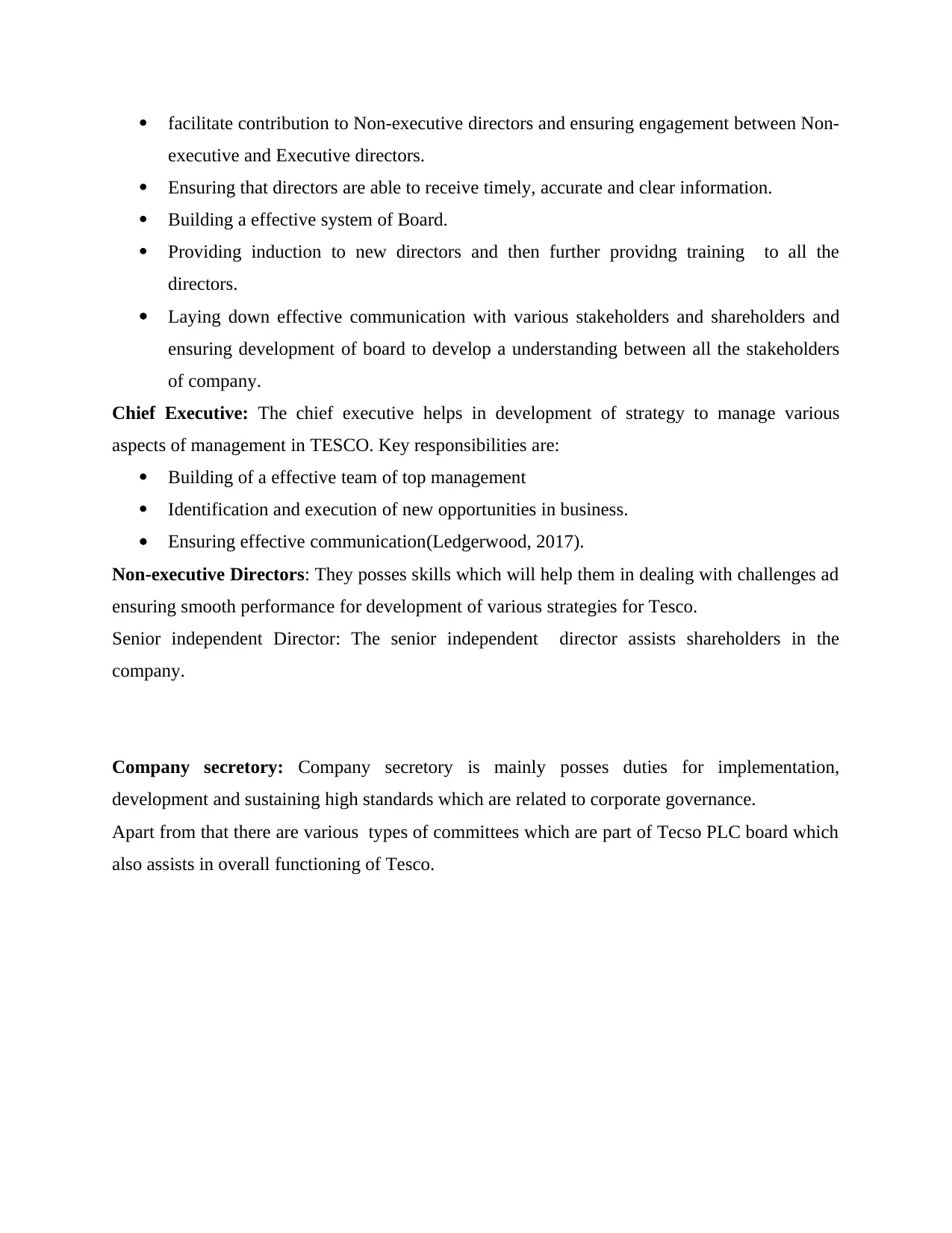
facilitate contribution to Non-executive directors and ensuring engagement between Non-
executive and Executive directors.
Ensuring that directors are able to receive timely, accurate and clear information.
Building a effective system of Board.
Providing induction to new directors and then further providng training to all the
directors.
Laying down effective communication with various stakeholders and shareholders and
ensuring development of board to develop a understanding between all the stakeholders
of company.
Chief Executive: The chief executive helps in development of strategy to manage various
aspects of management in TESCO. Key responsibilities are:
Building of a effective team of top management
Identification and execution of new opportunities in business.
Ensuring effective communication(Ledgerwood, 2017).
Non-executive Directors: They posses skills which will help them in dealing with challenges ad
ensuring smooth performance for development of various strategies for Tesco.
Senior independent Director: The senior independent director assists shareholders in the
company.
Company secretory: Company secretory is mainly posses duties for implementation,
development and sustaining high standards which are related to corporate governance.
Apart from that there are various types of committees which are part of Tecso PLC board which
also assists in overall functioning of Tesco.
executive and Executive directors.
Ensuring that directors are able to receive timely, accurate and clear information.
Building a effective system of Board.
Providing induction to new directors and then further providng training to all the
directors.
Laying down effective communication with various stakeholders and shareholders and
ensuring development of board to develop a understanding between all the stakeholders
of company.
Chief Executive: The chief executive helps in development of strategy to manage various
aspects of management in TESCO. Key responsibilities are:
Building of a effective team of top management
Identification and execution of new opportunities in business.
Ensuring effective communication(Ledgerwood, 2017).
Non-executive Directors: They posses skills which will help them in dealing with challenges ad
ensuring smooth performance for development of various strategies for Tesco.
Senior independent Director: The senior independent director assists shareholders in the
company.
Company secretory: Company secretory is mainly posses duties for implementation,
development and sustaining high standards which are related to corporate governance.
Apart from that there are various types of committees which are part of Tecso PLC board which
also assists in overall functioning of Tesco.
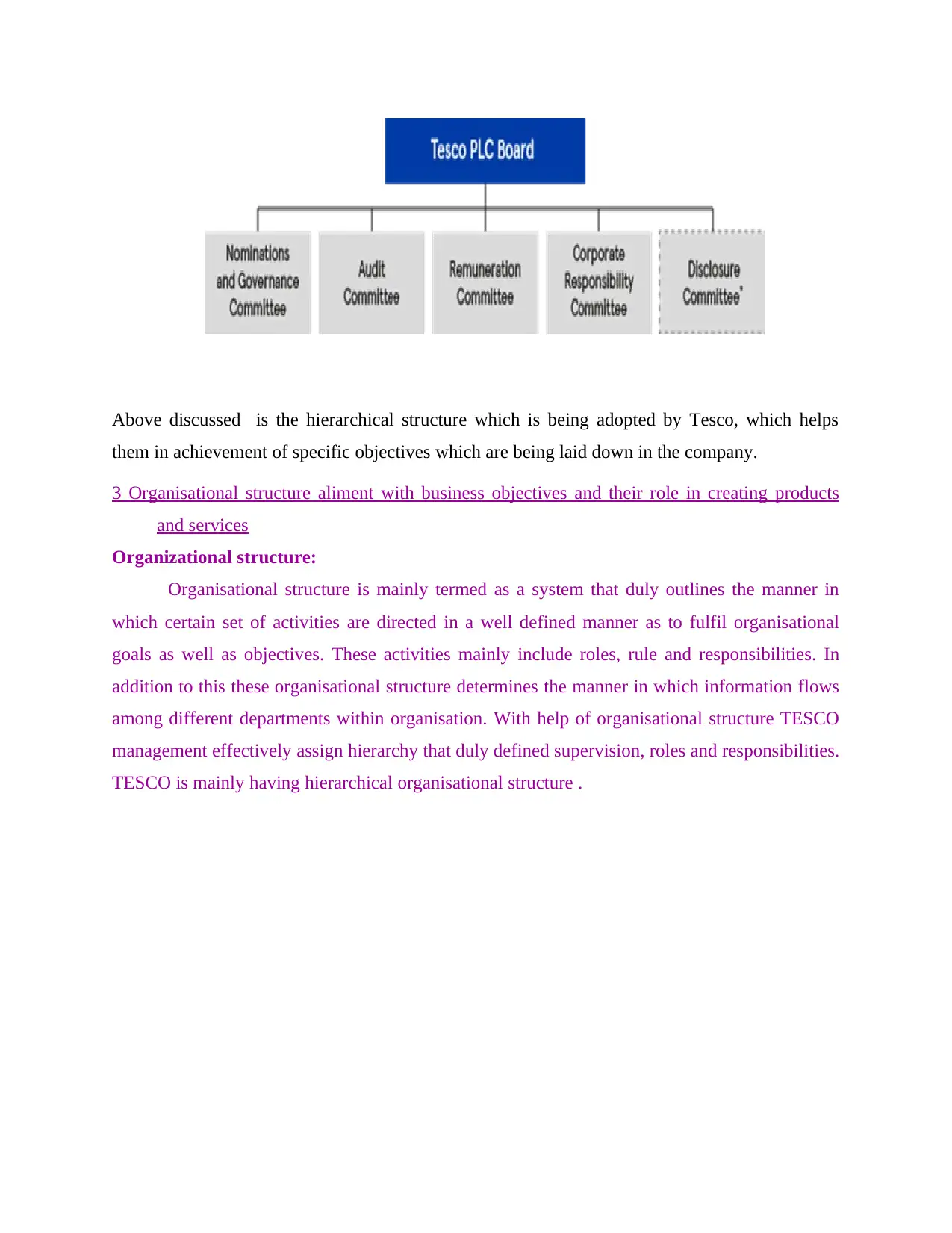
Above discussed is the hierarchical structure which is being adopted by Tesco, which helps
them in achievement of specific objectives which are being laid down in the company.
3 Organisational structure aliment with business objectives and their role in creating products
and services
Organizational structure:
Organisational structure is mainly termed as a system that duly outlines the manner in
which certain set of activities are directed in a well defined manner as to fulfil organisational
goals as well as objectives. These activities mainly include roles, rule and responsibilities. In
addition to this these organisational structure determines the manner in which information flows
among different departments within organisation. With help of organisational structure TESCO
management effectively assign hierarchy that duly defined supervision, roles and responsibilities.
TESCO is mainly having hierarchical organisational structure .
them in achievement of specific objectives which are being laid down in the company.
3 Organisational structure aliment with business objectives and their role in creating products
and services
Organizational structure:
Organisational structure is mainly termed as a system that duly outlines the manner in
which certain set of activities are directed in a well defined manner as to fulfil organisational
goals as well as objectives. These activities mainly include roles, rule and responsibilities. In
addition to this these organisational structure determines the manner in which information flows
among different departments within organisation. With help of organisational structure TESCO
management effectively assign hierarchy that duly defined supervision, roles and responsibilities.
TESCO is mainly having hierarchical organisational structure .
⊘ This is a preview!⊘
Do you want full access?
Subscribe today to unlock all pages.

Trusted by 1+ million students worldwide
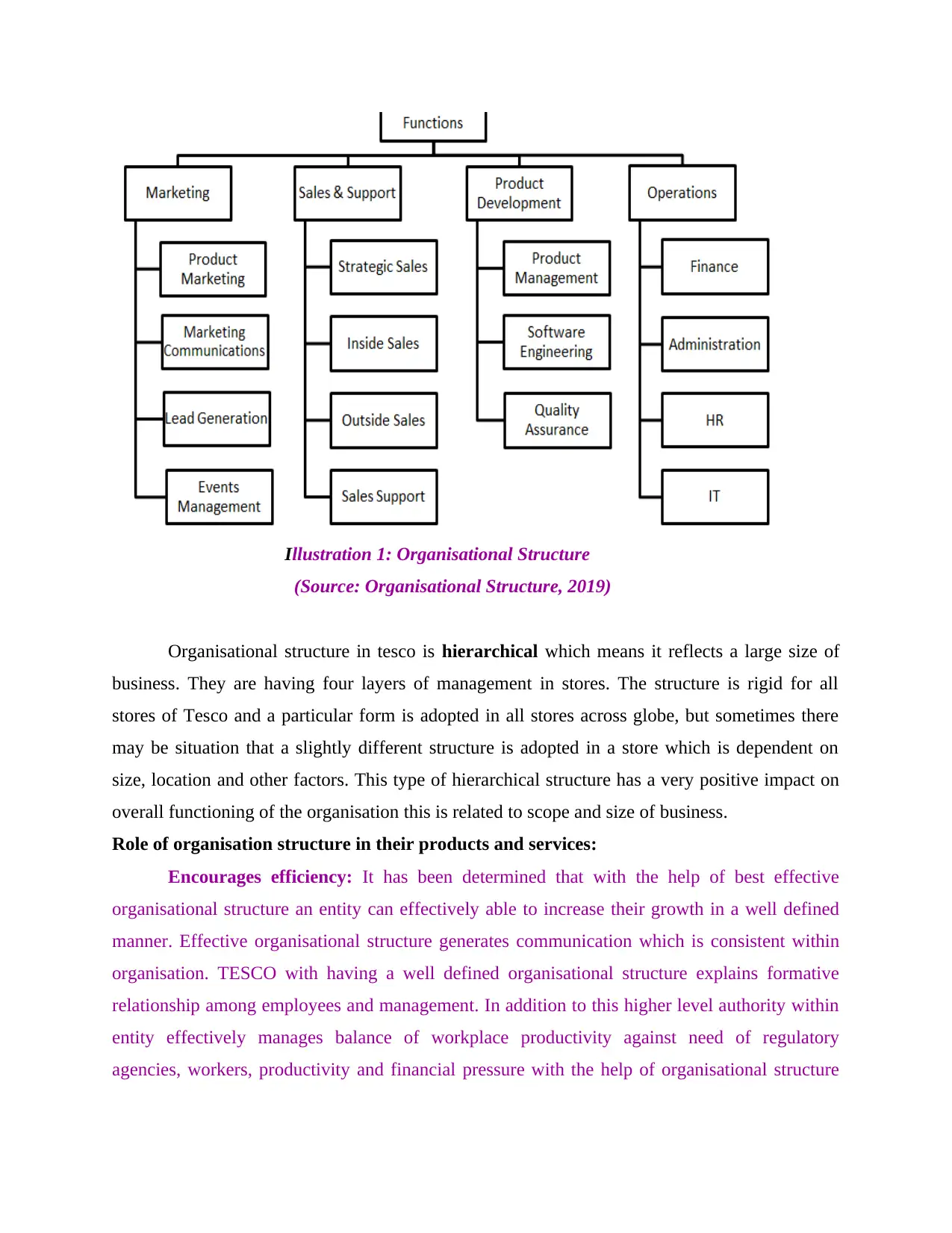
Illustration 1: Organisational Structure
(Source: Organisational Structure, 2019)
Organisational structure in tesco is hierarchical which means it reflects a large size of
business. They are having four layers of management in stores. The structure is rigid for all
stores of Tesco and a particular form is adopted in all stores across globe, but sometimes there
may be situation that a slightly different structure is adopted in a store which is dependent on
size, location and other factors. This type of hierarchical structure has a very positive impact on
overall functioning of the organisation this is related to scope and size of business.
Role of organisation structure in their products and services:
Encourages efficiency: It has been determined that with the help of best effective
organisational structure an entity can effectively able to increase their growth in a well defined
manner. Effective organisational structure generates communication which is consistent within
organisation. TESCO with having a well defined organisational structure explains formative
relationship among employees and management. In addition to this higher level authority within
entity effectively manages balance of workplace productivity against need of regulatory
agencies, workers, productivity and financial pressure with the help of organisational structure
(Source: Organisational Structure, 2019)
Organisational structure in tesco is hierarchical which means it reflects a large size of
business. They are having four layers of management in stores. The structure is rigid for all
stores of Tesco and a particular form is adopted in all stores across globe, but sometimes there
may be situation that a slightly different structure is adopted in a store which is dependent on
size, location and other factors. This type of hierarchical structure has a very positive impact on
overall functioning of the organisation this is related to scope and size of business.
Role of organisation structure in their products and services:
Encourages efficiency: It has been determined that with the help of best effective
organisational structure an entity can effectively able to increase their growth in a well defined
manner. Effective organisational structure generates communication which is consistent within
organisation. TESCO with having a well defined organisational structure explains formative
relationship among employees and management. In addition to this higher level authority within
entity effectively manages balance of workplace productivity against need of regulatory
agencies, workers, productivity and financial pressure with the help of organisational structure
Paraphrase This Document
Need a fresh take? Get an instant paraphrase of this document with our AI Paraphraser
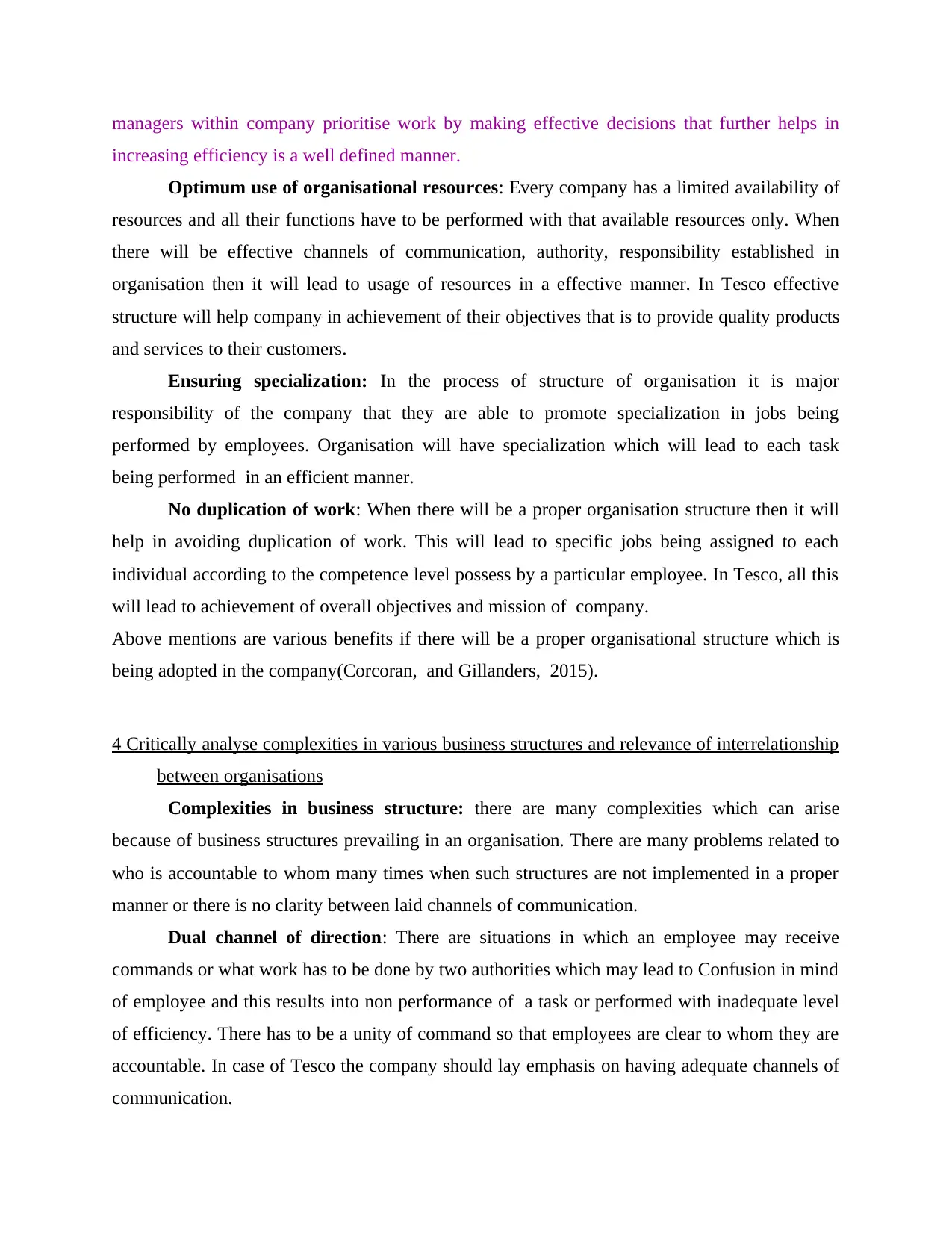
managers within company prioritise work by making effective decisions that further helps in
increasing efficiency is a well defined manner.
Optimum use of organisational resources: Every company has a limited availability of
resources and all their functions have to be performed with that available resources only. When
there will be effective channels of communication, authority, responsibility established in
organisation then it will lead to usage of resources in a effective manner. In Tesco effective
structure will help company in achievement of their objectives that is to provide quality products
and services to their customers.
Ensuring specialization: In the process of structure of organisation it is major
responsibility of the company that they are able to promote specialization in jobs being
performed by employees. Organisation will have specialization which will lead to each task
being performed in an efficient manner.
No duplication of work: When there will be a proper organisation structure then it will
help in avoiding duplication of work. This will lead to specific jobs being assigned to each
individual according to the competence level possess by a particular employee. In Tesco, all this
will lead to achievement of overall objectives and mission of company.
Above mentions are various benefits if there will be a proper organisational structure which is
being adopted in the company(Corcoran, and Gillanders, 2015).
4 Critically analyse complexities in various business structures and relevance of interrelationship
between organisations
Complexities in business structure: there are many complexities which can arise
because of business structures prevailing in an organisation. There are many problems related to
who is accountable to whom many times when such structures are not implemented in a proper
manner or there is no clarity between laid channels of communication.
Dual channel of direction: There are situations in which an employee may receive
commands or what work has to be done by two authorities which may lead to Confusion in mind
of employee and this results into non performance of a task or performed with inadequate level
of efficiency. There has to be a unity of command so that employees are clear to whom they are
accountable. In case of Tesco the company should lay emphasis on having adequate channels of
communication.
increasing efficiency is a well defined manner.
Optimum use of organisational resources: Every company has a limited availability of
resources and all their functions have to be performed with that available resources only. When
there will be effective channels of communication, authority, responsibility established in
organisation then it will lead to usage of resources in a effective manner. In Tesco effective
structure will help company in achievement of their objectives that is to provide quality products
and services to their customers.
Ensuring specialization: In the process of structure of organisation it is major
responsibility of the company that they are able to promote specialization in jobs being
performed by employees. Organisation will have specialization which will lead to each task
being performed in an efficient manner.
No duplication of work: When there will be a proper organisation structure then it will
help in avoiding duplication of work. This will lead to specific jobs being assigned to each
individual according to the competence level possess by a particular employee. In Tesco, all this
will lead to achievement of overall objectives and mission of company.
Above mentions are various benefits if there will be a proper organisational structure which is
being adopted in the company(Corcoran, and Gillanders, 2015).
4 Critically analyse complexities in various business structures and relevance of interrelationship
between organisations
Complexities in business structure: there are many complexities which can arise
because of business structures prevailing in an organisation. There are many problems related to
who is accountable to whom many times when such structures are not implemented in a proper
manner or there is no clarity between laid channels of communication.
Dual channel of direction: There are situations in which an employee may receive
commands or what work has to be done by two authorities which may lead to Confusion in mind
of employee and this results into non performance of a task or performed with inadequate level
of efficiency. There has to be a unity of command so that employees are clear to whom they are
accountable. In case of Tesco the company should lay emphasis on having adequate channels of
communication.
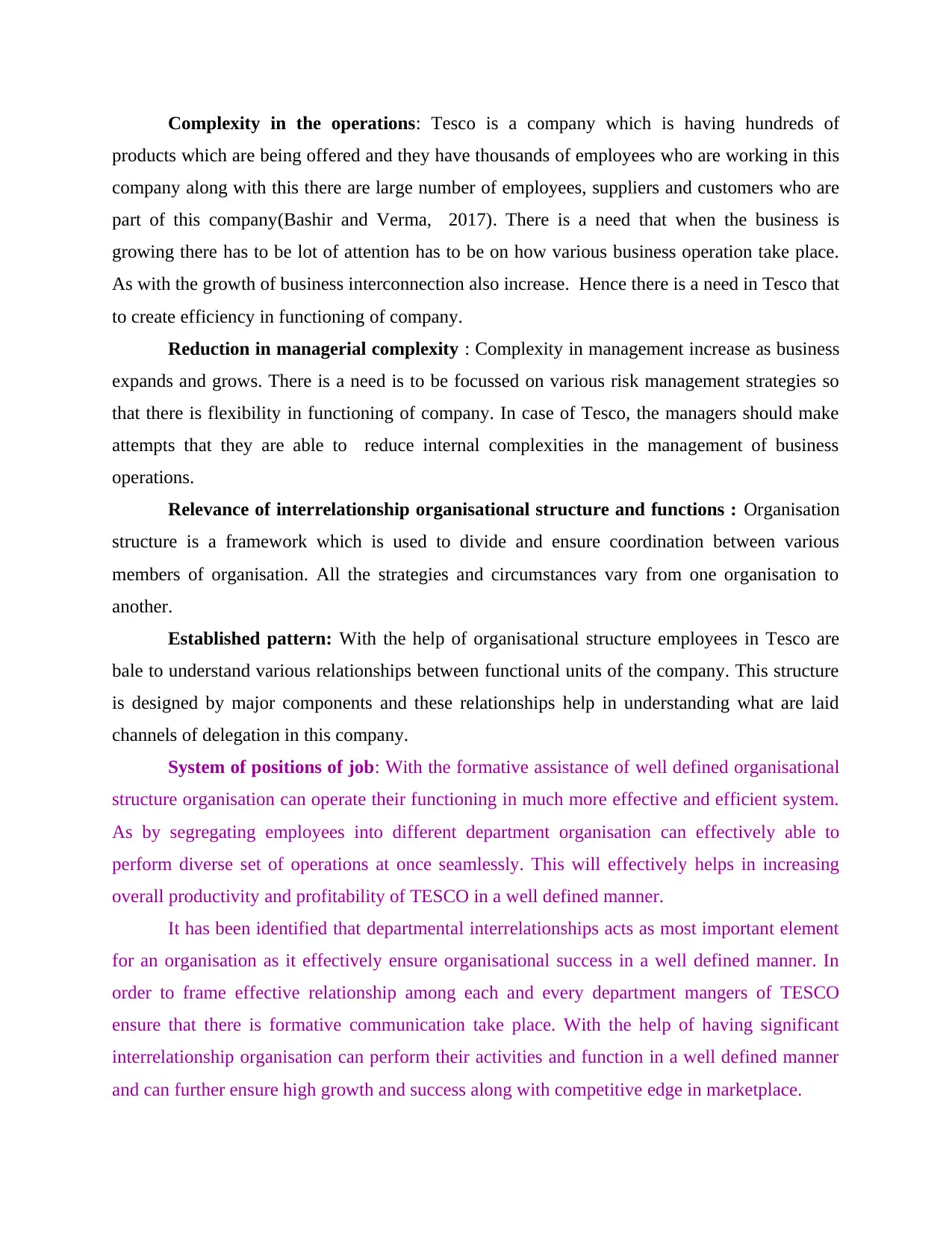
Complexity in the operations: Tesco is a company which is having hundreds of
products which are being offered and they have thousands of employees who are working in this
company along with this there are large number of employees, suppliers and customers who are
part of this company(Bashir and Verma, 2017). There is a need that when the business is
growing there has to be lot of attention has to be on how various business operation take place.
As with the growth of business interconnection also increase. Hence there is a need in Tesco that
to create efficiency in functioning of company.
Reduction in managerial complexity : Complexity in management increase as business
expands and grows. There is a need is to be focussed on various risk management strategies so
that there is flexibility in functioning of company. In case of Tesco, the managers should make
attempts that they are able to reduce internal complexities in the management of business
operations.
Relevance of interrelationship organisational structure and functions : Organisation
structure is a framework which is used to divide and ensure coordination between various
members of organisation. All the strategies and circumstances vary from one organisation to
another.
Established pattern: With the help of organisational structure employees in Tesco are
bale to understand various relationships between functional units of the company. This structure
is designed by major components and these relationships help in understanding what are laid
channels of delegation in this company.
System of positions of job: With the formative assistance of well defined organisational
structure organisation can operate their functioning in much more effective and efficient system.
As by segregating employees into different department organisation can effectively able to
perform diverse set of operations at once seamlessly. This will effectively helps in increasing
overall productivity and profitability of TESCO in a well defined manner.
It has been identified that departmental interrelationships acts as most important element
for an organisation as it effectively ensure organisational success in a well defined manner. In
order to frame effective relationship among each and every department mangers of TESCO
ensure that there is formative communication take place. With the help of having significant
interrelationship organisation can perform their activities and function in a well defined manner
and can further ensure high growth and success along with competitive edge in marketplace.
products which are being offered and they have thousands of employees who are working in this
company along with this there are large number of employees, suppliers and customers who are
part of this company(Bashir and Verma, 2017). There is a need that when the business is
growing there has to be lot of attention has to be on how various business operation take place.
As with the growth of business interconnection also increase. Hence there is a need in Tesco that
to create efficiency in functioning of company.
Reduction in managerial complexity : Complexity in management increase as business
expands and grows. There is a need is to be focussed on various risk management strategies so
that there is flexibility in functioning of company. In case of Tesco, the managers should make
attempts that they are able to reduce internal complexities in the management of business
operations.
Relevance of interrelationship organisational structure and functions : Organisation
structure is a framework which is used to divide and ensure coordination between various
members of organisation. All the strategies and circumstances vary from one organisation to
another.
Established pattern: With the help of organisational structure employees in Tesco are
bale to understand various relationships between functional units of the company. This structure
is designed by major components and these relationships help in understanding what are laid
channels of delegation in this company.
System of positions of job: With the formative assistance of well defined organisational
structure organisation can operate their functioning in much more effective and efficient system.
As by segregating employees into different department organisation can effectively able to
perform diverse set of operations at once seamlessly. This will effectively helps in increasing
overall productivity and profitability of TESCO in a well defined manner.
It has been identified that departmental interrelationships acts as most important element
for an organisation as it effectively ensure organisational success in a well defined manner. In
order to frame effective relationship among each and every department mangers of TESCO
ensure that there is formative communication take place. With the help of having significant
interrelationship organisation can perform their activities and function in a well defined manner
and can further ensure high growth and success along with competitive edge in marketplace.
⊘ This is a preview!⊘
Do you want full access?
Subscribe today to unlock all pages.

Trusted by 1+ million students worldwide
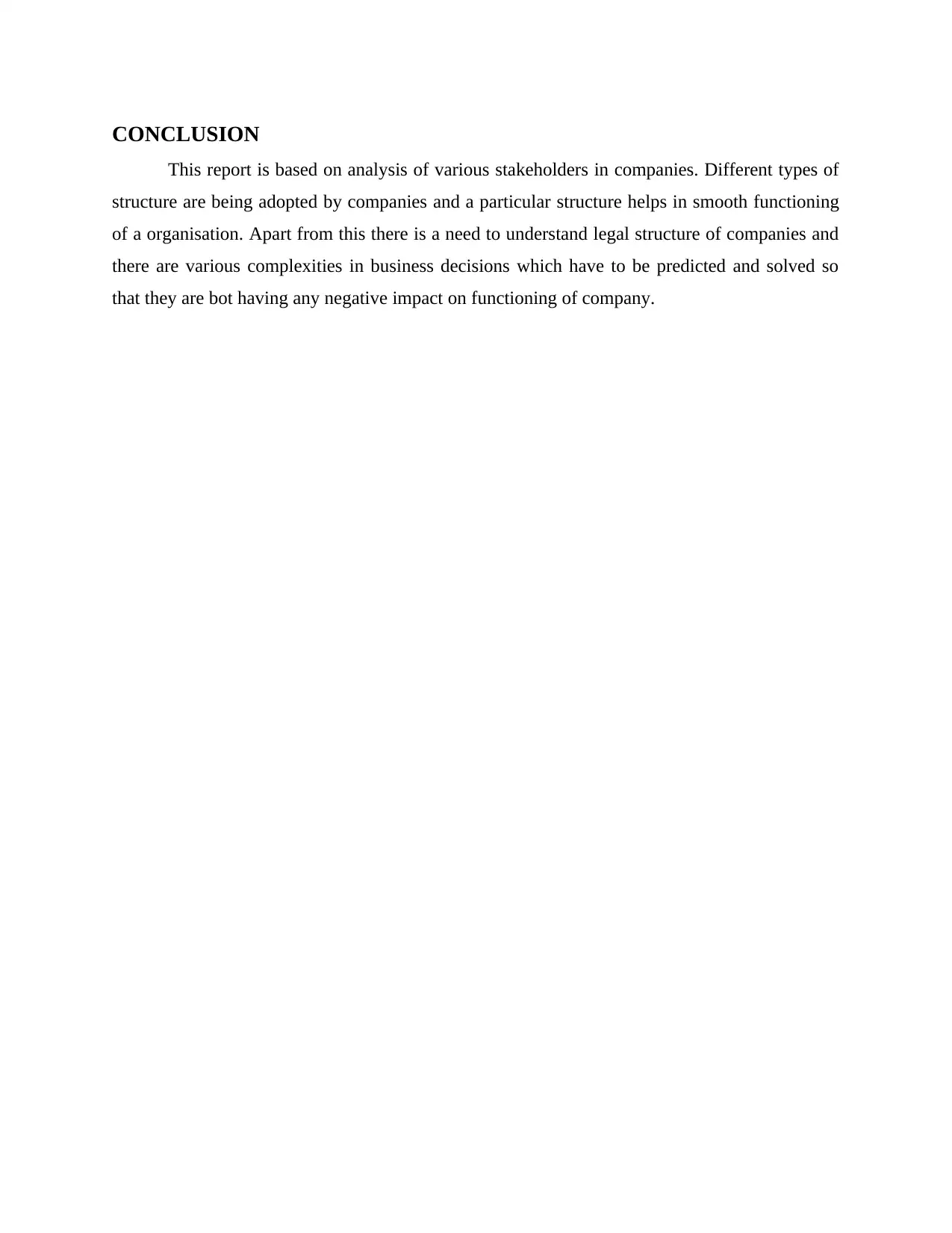
CONCLUSION
This report is based on analysis of various stakeholders in companies. Different types of
structure are being adopted by companies and a particular structure helps in smooth functioning
of a organisation. Apart from this there is a need to understand legal structure of companies and
there are various complexities in business decisions which have to be predicted and solved so
that they are bot having any negative impact on functioning of company.
This report is based on analysis of various stakeholders in companies. Different types of
structure are being adopted by companies and a particular structure helps in smooth functioning
of a organisation. Apart from this there is a need to understand legal structure of companies and
there are various complexities in business decisions which have to be predicted and solved so
that they are bot having any negative impact on functioning of company.
Paraphrase This Document
Need a fresh take? Get an instant paraphrase of this document with our AI Paraphraser
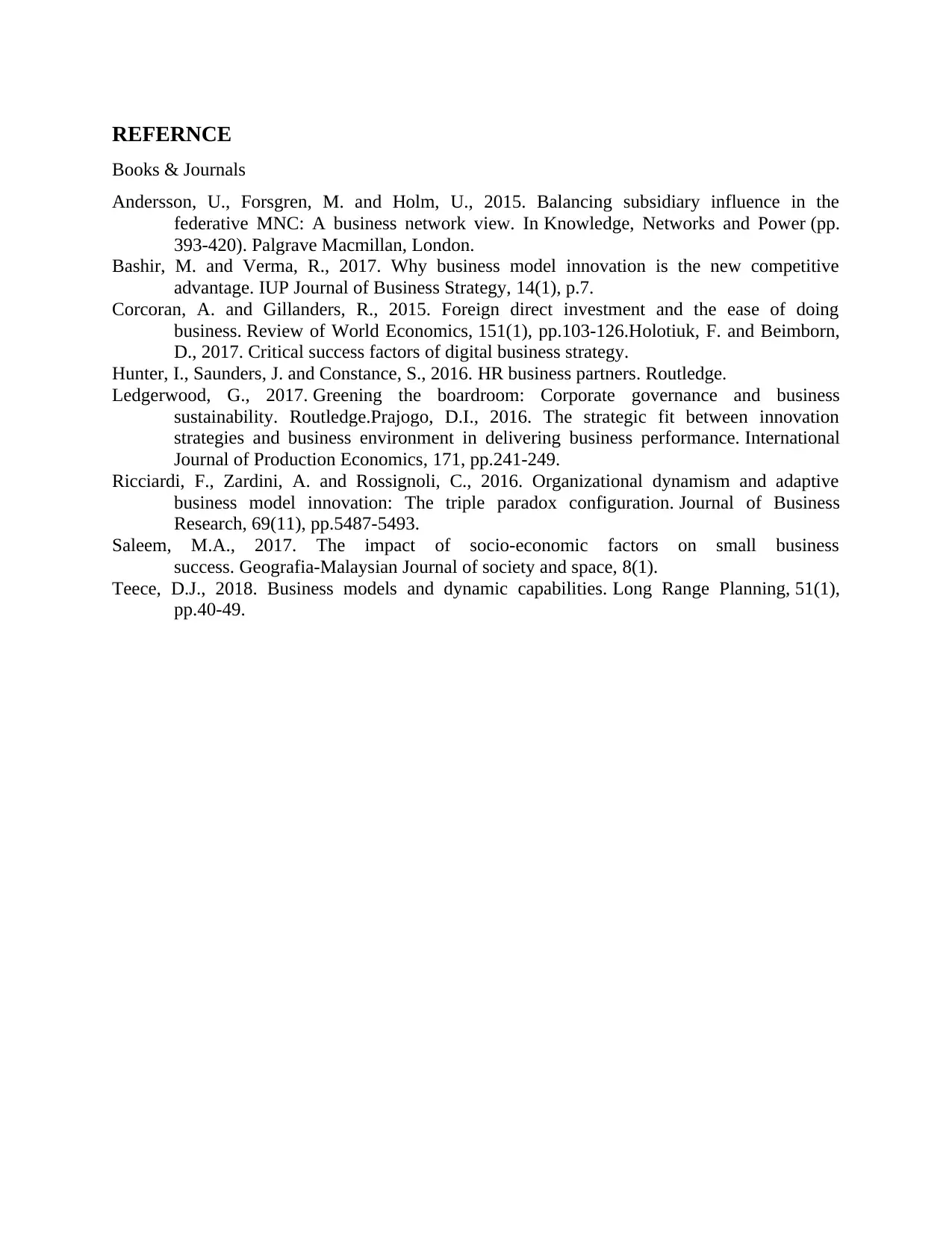
REFERNCE
Books & Journals
Andersson, U., Forsgren, M. and Holm, U., 2015. Balancing subsidiary influence in the
federative MNC: A business network view. In Knowledge, Networks and Power (pp.
393-420). Palgrave Macmillan, London.
Bashir, M. and Verma, R., 2017. Why business model innovation is the new competitive
advantage. IUP Journal of Business Strategy, 14(1), p.7.
Corcoran, A. and Gillanders, R., 2015. Foreign direct investment and the ease of doing
business. Review of World Economics, 151(1), pp.103-126.Holotiuk, F. and Beimborn,
D., 2017. Critical success factors of digital business strategy.
Hunter, I., Saunders, J. and Constance, S., 2016. HR business partners. Routledge.
Ledgerwood, G., 2017. Greening the boardroom: Corporate governance and business
sustainability. Routledge.Prajogo, D.I., 2016. The strategic fit between innovation
strategies and business environment in delivering business performance. International
Journal of Production Economics, 171, pp.241-249.
Ricciardi, F., Zardini, A. and Rossignoli, C., 2016. Organizational dynamism and adaptive
business model innovation: The triple paradox configuration. Journal of Business
Research, 69(11), pp.5487-5493.
Saleem, M.A., 2017. The impact of socio-economic factors on small business
success. Geografia-Malaysian Journal of society and space, 8(1).
Teece, D.J., 2018. Business models and dynamic capabilities. Long Range Planning, 51(1),
pp.40-49.
Books & Journals
Andersson, U., Forsgren, M. and Holm, U., 2015. Balancing subsidiary influence in the
federative MNC: A business network view. In Knowledge, Networks and Power (pp.
393-420). Palgrave Macmillan, London.
Bashir, M. and Verma, R., 2017. Why business model innovation is the new competitive
advantage. IUP Journal of Business Strategy, 14(1), p.7.
Corcoran, A. and Gillanders, R., 2015. Foreign direct investment and the ease of doing
business. Review of World Economics, 151(1), pp.103-126.Holotiuk, F. and Beimborn,
D., 2017. Critical success factors of digital business strategy.
Hunter, I., Saunders, J. and Constance, S., 2016. HR business partners. Routledge.
Ledgerwood, G., 2017. Greening the boardroom: Corporate governance and business
sustainability. Routledge.Prajogo, D.I., 2016. The strategic fit between innovation
strategies and business environment in delivering business performance. International
Journal of Production Economics, 171, pp.241-249.
Ricciardi, F., Zardini, A. and Rossignoli, C., 2016. Organizational dynamism and adaptive
business model innovation: The triple paradox configuration. Journal of Business
Research, 69(11), pp.5487-5493.
Saleem, M.A., 2017. The impact of socio-economic factors on small business
success. Geografia-Malaysian Journal of society and space, 8(1).
Teece, D.J., 2018. Business models and dynamic capabilities. Long Range Planning, 51(1),
pp.40-49.
1 out of 11
Related Documents
Your All-in-One AI-Powered Toolkit for Academic Success.
+13062052269
info@desklib.com
Available 24*7 on WhatsApp / Email
![[object Object]](/_next/static/media/star-bottom.7253800d.svg)
Unlock your academic potential
Copyright © 2020–2025 A2Z Services. All Rights Reserved. Developed and managed by ZUCOL.




